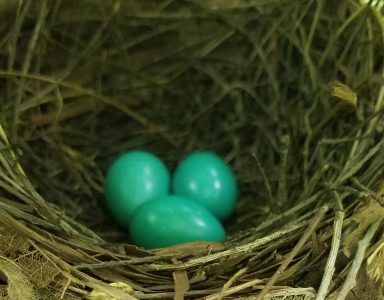During my many walks in Eliza Howell Park in Detroit in recent years, I have confirmed the presence of 15 different mammals (not including smaller mammals like voles, deer mice, and bats).
When animals are classified by what they eat, they are usually identified as herbivores, omnivores, or carnivores. Among the Eliza Howell herbivores is the Groundhog. In this picture, an adult is on the left, an immature on the right.

Herbivores eat plants and only plants, many having digestive systems that are able to digest many different kinds of plants, including grasses.
Of the 5 herbivores that I am aware of in the park, the White-tailed Deer is the most common. In the winter, when they are sometimes in herds, I have seen as many as 10 together. Here is a stag, watching me as I watched him.

I do not (yet) have any pictures of the two aquatic herbivores found in EHP: Muskrat and American Beaver. Beaver is the mammal most recently added to the list of those found in Eliza Howell and their practice of eating the stems, bark, and twigs of trees is evidenced by the many small trees they cut down and remove along the river.
The Eastern Cottontail is a fairly common herbivore in the park.

Omnivores are animals that eat both other animals and (parts of) plants. They may be primarily animal eaters or primarily plant eaters and omnivores make up the largest number of Eliza Howell mammal species.
The Virginia Opossum is largely nocturnal, but I do encounter one during the day from time to time. It is often slow moving and may allow one to get quite close.

Many omnivores are opportunistic feeders, eating whatever food is convenient. These include the various squirrels found in Eliza Howell. Tree squirrels are Fox Squirrel, Gray Squirrel (black variation in the picture below), and Red Squirrel. The ground squirrel is the Eastern Chipmunk. Squirrels eat seeds and nuts and fruit, but they may also eat eggs, insects, baby birds.
(Clockwise from top left: Fox Squirrel, Red Squirrel, black Gray Squirrel, and Eastern Chipmunk)

Raccoons will eat almost anything, but they especially like small animals found in water, such as clams, crayfish, and frogs. I have seen them – and their tracks – most frequently by the river. They are also primarily nocturnal, sometimes seen resting in trees during the day. They also den in trees.

Photo by Kevin Murphy
Striped Skunk, another omnivore found in Eliza Howell, is mostly active at night and rarely seen.
Red Fox and Coyote are two mammals that are often considered carnivores, but perhaps should more accurately be considered omnivores. They eat mostly animals and carrion, but also eat fruit and berries.
In the last few years, I have seen Coyote more frequently than Red Fox in Eliza Howell. This picture of a Coyote was taken in nearby Rouge Park in Detroit.

Photo by Kevin Murphy
Carnivores are animals whose diet consists of other animals. The one mammal that I have seen in EHP that is strictly carnivore is Mink. It is semiaquatic (I have seen them only by the river) and eats fish, crayfish, mice, muskrats, birds, etc. I see it only occasionally.
—-
As noted above, these 15 species are not the only mammals in the park. There are some smaller species that I am aware of and, without a doubt, other species that I have not yet found. One example: I think the habitat is perfect for flying squirrels, but I have not yet seen any evidence of these nocturnal mammals.
There is much more to learn about my favorite urban park.
